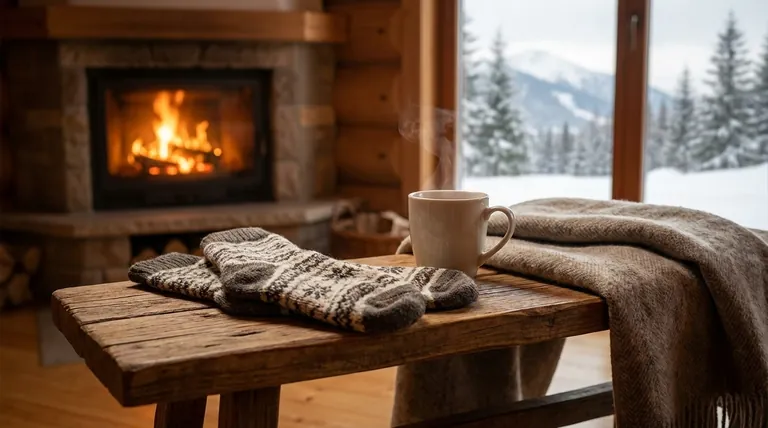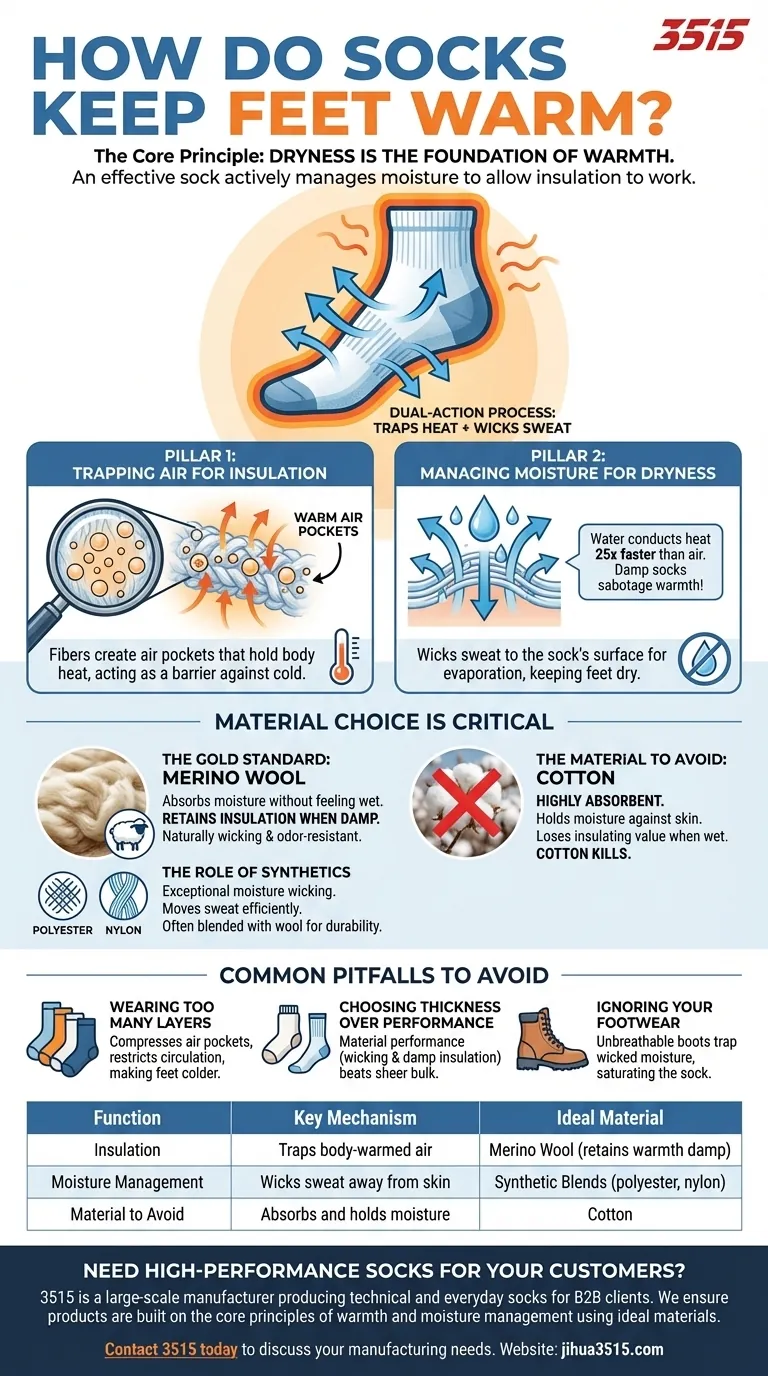The primary function of a sock is not simply to add a layer of material, but to manage the environment around your foot. Socks keep feet warm through a critical dual-action process: they trap a layer of insulating air heated by your body and, just as importantly, they pull sweat away from your skin to keep your feet dry. A wet foot will lose heat rapidly, regardless of the insulation you wear.
The core principle of keeping feet warm is that dryness is the foundation of warmth. An effective sock doesn't just insulate; it actively manages moisture to ensure the insulation can do its job properly.

The Two Pillars of Foot Warmth
To understand how socks function, you must see them as a technical system managing both heat and moisture. Neglecting either aspect will result in cold feet.
Pillar 1: Trapping Air for Insulation
The fibers of a sock create countless tiny air pockets. Your body heat warms the air in these pockets, and the sock's structure holds that warm air in place, acting as a barrier against the colder outside air.
This is why thicker, loftier socks, such as those made from wool, often feel warmer. They are able to trap a larger volume of insulating air.
Pillar 2: Managing Moisture for Dryness
This is the most critical and often misunderstood function. Your feet can produce a significant amount of sweat, even in cold weather. If that moisture stays on your skin, it will make you cold.
Water conducts heat away from your body 25 times faster than air. A sock that gets damp and holds moisture against your skin will actively sabotage your warmth.
Effective socks wick moisture. This means they pull sweat from the surface of your skin to the outer layer of the sock, where it can evaporate into your footwear. This process is essential for maintaining a dry, warm environment.
Why Material Choice is Critical
The material a sock is made from dictates its ability to insulate and manage moisture. This choice is more important than almost any other factor.
The Gold Standard: Merino Wool
Merino wool is the ideal material for cold-weather socks. It excels because it can absorb a significant amount of moisture without feeling wet to the touch.
Crucially, wool retains its insulating properties even when damp, a trait that sets it apart from other materials. It is also naturally moisture-wicking and odor-resistant.
The Role of Synthetics
Synthetic fibers like polyester and nylon are exceptional at wicking moisture. They don't absorb much water and instead move it away from the skin very efficiently.
These fibers are often blended with wool to enhance durability and the speed of moisture transfer, creating a high-performance hybrid sock.
The Material to Avoid: Cotton
Cotton is the worst possible choice for cold and damp conditions. It is highly absorbent and holds moisture directly against your skin, a recipe for dangerously cold feet.
Once wet, cotton loses all of its insulating value and actively pulls heat from your body. This is why experienced outdoors professionals have a saying: "cotton kills."
Common Pitfalls to Avoid
Simply putting on socks isn't enough. Certain common habits can completely undermine their effectiveness and lead to colder feet.
Mistake 1: Wearing Too Many Layers
Stuffing multiple pairs of thick socks into your boot is often counterproductive. This can make the boot too tight, compressing the insulating air pockets in the socks and, more importantly, restricting blood circulation to your feet.
Reduced blood flow means less warm blood reaches your toes, making them feel colder regardless of what you're wearing.
Mistake 2: Choosing Thickness Over Performance
A thick cotton sock will always be a worse choice than a medium-weight merino wool sock. The performance of the material—its ability to wick moisture and insulate when damp—is far more important than its sheer bulk.
Mistake 3: Ignoring Your Footwear
A sock can only do so much. If your boots are not breathable, the moisture wicked by the sock has nowhere to go. It becomes trapped inside the boot, eventually saturating the sock and defeating the entire system.
Making the Right Choice for Your Goal
Select your sock system based on your activity level and the conditions you face.
- If your primary focus is everyday cold protection: A single pair of medium-weight merino wool or wool-blend socks provides an excellent balance of warmth and moisture management.
- If your primary focus is active sports in the cold: Use a two-sock system with a thin, synthetic liner sock to wick sweat rapidly and a thicker wool-blend sock over it for insulation.
- If your primary focus is extreme cold or poor circulation: Start with a high-quality thermal wool sock and consider augmenting it with accessories like heated insoles or disposable toe warmers.
By focusing on keeping your feet dry first, you empower your socks to provide the insulation you need to stay warm.
Summary Table:
| Function | Key Mechanism | Ideal Material |
|---|---|---|
| Insulation | Traps body-warmed air in fabric pockets | Merino Wool (retains warmth when damp) |
| Moisture Management | Wicks sweat away from skin to keep feet dry | Synthetic Blends (polyester, nylon) |
| Material to Avoid | Absorbs and holds moisture, causing heat loss | Cotton |
Need High-Performance Socks for Your Customers?
As a large-scale manufacturer, 3515 produces a comprehensive range of technical and everyday socks for distributors, brand owners, and bulk clients. Our expertise ensures your products are built on the core principles of warmth and moisture management, using ideal materials like merino wool and high-tech synthetics.
We can help you develop socks that keep end-users warm, dry, and comfortable in any condition.
Contact 3515 today to discuss your manufacturing needs and elevate your footwear line.
Visual Guide

Related Products
- Dial Closure Leather Business Casual Shoes for Wholesale & Private Label
- Factory Direct Wholesale Leather Comfort Shoes with Dial Closure
- Wholesale Leather Derby Shoes Manufacturer | Customizable Business & Dress Footwear
- Wholesale Comfort Leather Business Shoes with Dial Lacing System
- Durable Goodyear Welt Leather Work Boots for Wholesale & Private Label
People Also Ask
- What should consumers look for to avoid misleading claims about leather quality? A Guide to Identifying Genuine Quality
- What should be known about genuine leather for shoes? Don't Be Misled by the Label
- How can one determine if business casual shoes are appropriate? A Guide to Professional Footwear Choices
- What are the key characteristics of business casual shoes? Achieve Polished Versatility for Your Wardrobe
- How can one identify authentic leather footwear? A Guide to Spotting Genuine vs. Fake



















